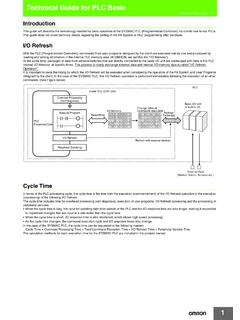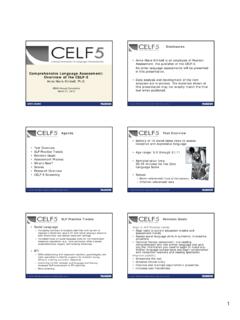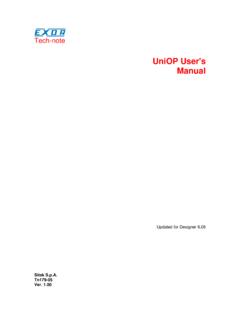Transcription of IRDS 2021 More Moore
1 INTERNATIONAL. ROADMAP. FOR. DEVICES AND SYSTEMS . 2021 UPDATE. MORE Moore . THE IRDS IS DEVISED AND INTENDED FOR TECHNOLOGY ASSESSMENT ONLY AND IS WITHOUT REGARD TO ANY. COMMERCIAL CONSIDERATIONS PERTAINING TO INDIVIDUAL PRODUCTS OR EQUIPMENT. THE INTERNATIONAL ROADMAP FOR DEVICES AND SYSTEMS: 2021. COPYRIGHT 2021 IEEE. ALL RIGHTS RESERVED. 2021 IEEE. Personal use of this material is permitted. Permission from IEEE must be obtained for all other uses, in any current or future media, including reprinting/republishing this material for advertising or promotional purposes, creating new collective works, for resale or redistribution to servers or lists, or reuse of any copyrighted component of this work in other works.
2 THE INTERNATIONAL ROADMAP FOR DEVICES AND SYSTEMS: 2021. COPYRIGHT 2021 IEEE. ALL RIGHTS RESERVED. Acknowledgments i Table of Contents Acknowledgments .. iii 1. Introduction ..1. Current State of Technology .. 2. Drivers and Technology Targets .. 2. 2. Summary and Key Points ..3. 3. Challenges ..4. Near-term Challenges .. 4. Long-term Challenges .. 5. 4. Technology Requirements Logic Technologies ..6. Ground Rules Scaling .. 6. Performance 9. Performance-Power-Area (PPA) Scaling .. 13. System-On-Chip (SoC) PPA 15. Interconnect Technology 17. Device Reliability .. 19. 3D Heterogeneous Integration .. 22. Defectivity Requirements .. 23. 5. Technology Requirements memory Technologies.
3 24. DRAM .. 24. NVM flash .. 24. NVM Emerging .. 26. 6. Potential Solutions .. 29. 7. Cross Teams .. 30. 8. Conclusions and Recommendations .. 30. 9. References .. 31. THE INTERNATIONAL ROADMAP FOR DEVICES AND SYSTEMS: 2021. COPYRIGHT 2021 IEEE. ALL RIGHTS RESERVED. ii Acknowledgments List of Figures Figure MM-1 Big data and instant data .. 1. Figure MM-2 Projected scaling of key ground rules .. 8. Figure MM-3 Scaling of standard cell height and width through fin depopulation and device stacking .. 8. Figure MM-4 Planar to GAA transition [11].. 10. Figure MM-5 Evolution of device architectures in the IRDS More Moore roadmap .. 10. Figure MM-6 Scaling trend of device S/D access resistance (Rsd) and k-value of device spacer.
4 [4] .. 12. Figure MM-7 NAND2-equivalent standard cell count (left) and 111-bitcell (right) scaling in an 80mm2 15. Figure MM-8 CPU clock frequency and power@iso- frequency (ref: 2021) scaling .. 16. Figure MM-9 Scaling projection of computation throughput of CPU cores at the maximum clock frequency and at thermally constrained average frequency .. 17. Figure MM-10 Degradation paths in low- damascene structure .. 19. Figure MM-11 (left) A 3D NAND array based on a vertical channel architecture. (right) BiCS (bit cost scalable) a 3D NAND structure using a punch and plug process [41].. 25. Figure MM-12 Schematic view of (a) 3D cross-point architecture using a vertical RRAM cell and (b) a vertical MOSFET transistor as the bit-line selector to enable the random access capability of individual cells in the array [52].
5 28. List of Tables Table MM-1 More Moore Logic Core Device Technology Roadmap .. 4. Table MM-2 More Moore DRAM Technology Roadmap .. 4. Table MM-3 More Moore flash Technology Roadmap .. 4. Table MM-4 More Moore NVM Technology 4. Table MM-5 Difficult Challenges Near-term .. 4. Table MM-6 Difficult Challenges Long-term .. 5. Table MM-7 Device Architecture and Ground Rules Roadmap for Logic Devices.. 7. Table MM-8 Device Roadmap and Technology Anchors for More Moore Scaling.. 9. Table MM-9 Projected Electrical Specifications of Logic Core Device .. 13. Table MM-10 Projected Performance-Power-Area (PPA) 14. Table MM-11 Power and Performance Scaling of SoC .. 16. Table MM-12 Interconnect Difficult Challenges.
6 17. Table MM-13 Interconnect Roadmap for Scaling .. 18. Table MM-14 Device Reliability Difficult Challenges .. 21. Table MM-15 Defectivity (D0) Requirements of an 80mm2 Die.. 24. Table MM-16 Potential Solutions Near-term .. 29. Table MM-17 Potential Solutions Long-term .. 29. THE INTERNATIONAL ROADMAP FOR DEVICES AND SYSTEMS: 2021. COPYRIGHT 2021 IEEE. ALL RIGHTS RESERVED. Acknowledgments iii ACKNOWLEDGMENTS. MORE Moore TEAM. & Canada ASIA. Anshul A. Vyas Applied Materials Atsushi Hori Tokyo Inst of Technology Arvind Kumar IBM Digh Hisamoto Hitachi Bhagawan Sahu Global Foundries Hajime Nakabasyashi TEL. Charles Kin P. Cheung NIST Hitoshi Wakabayashi Tokyo Inst of Technology Chorng-Ping Chang AMAT Jiro Ida Kanazawa IT.
7 Christopher Henderson Semitracks Kazuyuki Tomida Sony Gennadi Bersuker Aerospace Corporation Kunihiko Iwamoro ROHM. Gerhard Klimeck Purdue Univ. Kuniyuki Kakushima Tokyo Inst of Technology Huiming Bu IBM Masahiko Ikeno Hitachi High-Tech James Stathis IBM Masami Hane Renesas Jeongdong Cho Tech Insights Shinichi Ogawa AIST. Jim Fonseca Purdue Univ. Shinichi Takagi University of Tokyo Joe Brewer Univ. Florida Takashi Matsukawa AIST. Joel Barnett TEL Tesuo Endo Tohoku University Kirk Prall Micron Tetsu Tanaka Tohoku University Kwok Ng SRC Toshiro Hiramoto University of Tokyo Lars Liebmann TEL Yasuo Kunii Analysis Atelier Masako Kodera Mosos Lake Industries Yasushi Akasaka TEL.
8 Matthias Passlack TSMC Yoshihiro Hayashi Keio University Mehdi Salmani Boston Consulting Group Jongwoo Park Samsung Philip Wong Stanford Univ. Moon-Young Jeong Samsung Prasad Sarangapani Synopsys Cheng-tzung Tsai UMC. Qi Xiang Xilinx Geoffrey Yeap TSMC. Rich Liu Macronix SangBum Kim IBM. Saumitra Mehrotra NXP EUROPE. Sergei Drizlikh Samsung Christiane Le Tiec MKS Instruments Siddharth Potbhare NIST. Francis Balestra IMEP Grenoble SungGeun Kim Microsoft Fred Kuper NXP. Takeshi Nogami IBM. Gerben Doornbos TSMC. Wilman Tsai Stanford Univ. Herve Jaouen ST. Witek Maszara V-tek Consulting Jurgen Lorenz Fraunhofer IISB. Yanzhong Xu Microsoft Karim Cherkaoui Tyndall National Inst.
9 Yuzo Fukuzaki Tech Insights Kristin DeMeyer IMEC. Laurent Le-Pailleur ST. Malgorzata Jurczak LAM Research Mark van Dal TSMC. Mustafa Badaroglu (chair) Qualcomm Technologies Olivier Faynot LETI. Paul Mertens IMEC. Peter Ramm Fraunhofer EMFT. Ray Duffy Tyndall National Inst. Robert Lander NXP. Thierry Poiroux LETI. Yannick Le Tiec LETI. THE INTERNATIONAL ROADMAP FOR DEVICES AND SYSTEMS: 2021. COPYRIGHT 2021 IEEE. ALL RIGHTS RESERVED. Introduction 1. MORE Moore . 1. INTRODUCTION. System scaling enabled by Moore 's scaling is increasingly challenged by the scarcity of resources such as power and interconnect bandwidth. This has become more challenging under the requirements of seamless interaction between big data and instant data (Figure MM-1).
10 Instant data generation requires ultra-low-power devices with an always-on . feature at the same time with high-performance devices that can generate the data instantly. Big data requires abundant computing, communication bandwidth, and memory resources to generate the service and information that clients need. The More Moore International Focus Team (IFT) of the International Roadmap of Devices and Systems (IRDS) provides physical, electrical, and reliability requirements for logic and memory technologies to sustain power, performance, area, cost (PPAC) scaling for big data, mobility, and cloud ( , Internet-of-Things (IoT) and server) applications. This is done over a time horizon of 15 years for mainstream/high-volume manufacturing (HVM).






